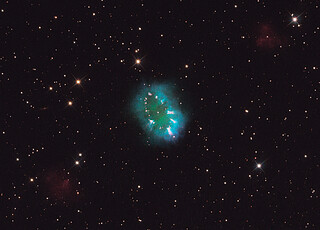Hubble Heritage (STScI/AURA) | 2011 Aug 11
A Cosmic Necklace Larger than a Solar System
The "Necklace Nebula," also called PN G054.2-03.4, is the exploded aftermath of a giant star that came too close to its Sun-like binary companion. The two stars that produced the Necklace Nebula live in a relatively small orbit about each other. They have a period of 1.2 days and a separation on the order of 5 times the radius of the Sun.
Evidence for the existence of the two-body system arises from the nebula's appearance of a half-light-year-wide equatorial ring of dense material near the inner portion of the nebula. The expanding elliptical ring is composed of bright, dense knots of glowing hydrogen and oxygen gas. Each knot also dons a small tail pointing away from the central star. The clumpy appearance of the ring may have been caused by density fluctuations in the shared material of the binary stars prior to the explosion, or possibly by magnetic field lines present in the giant star as it began to expand and shed off its outer layers.
A fast, collimated outflow of nitrogen gas from the binary system has formed faint lobes and polar caps extending in the direction perpendicular to the ring. Edge to edge, the nebula is nearly 9 light-years long, over twice the distance between our Sun and our nearest stellar companion, Proxima Centauri.
Astronomers studying PN G054.2-03.4 predict that the outer lobes of gas were ejected about 10,000 years ago, before the two stars began sharing material. The inner ring of material was created only about 5,000 years ago (and relatively recent on astronomical timescales), and shares the same plane as the orbit of the two stars.
The Necklace Nebula is located about 15,000 light-years away in the northern constellation Sagitta. It was recently discovered in 2005 from the Isaac Newton Telescope Photometric H-alpha Survey (IPHAS), a ground-based H-alpha planetary nebula study of the North Galactic Plane.
The Wide Field Camera 3 (WFC3) detector onboard Hubble was used to observe the Necklace Nebula on July 2, 2011. Hubble's WFC3 broadband filters, which show the colors of the galactic field stars, were used along with narrowband filters that show emission from the gases that make up the planetary nebula. In this composite image, ionized hydrogen gas is shown in blue, oxygen gas in green, and nitrogen gas in red. The field stars appear mainly white, with a reddish tint, which is indicative of the older population stars that make up the disk of our Milky Way galaxy.
Hubble Offers a Dazzling View of the 'Necklace' Nebula
HubbleSite | STScI-2011-24 | 2011 Aug 11
A giant cosmic necklace glows brightly in this NASA Hubble Space Telescope image.
The object, aptly named the Necklace Nebula, is a recently discovered planetary nebula, the glowing remains of an ordinary, Sun-like star. The nebula consists of a bright ring, measuring 12 trillion miles across, dotted with dense, bright knots of gas that resemble diamonds in a necklace. The knots glow brightly due to absorption of ultraviolet light from the central stars.
A pair of stars orbiting very close together produced the nebula, also called PN G054.2-03.4. About 10,000 years ago one of the aging stars ballooned to the point where it enveloped its companion star. This caused the larger star to spin so fast that much of its gaseous envelope expanded into space. Due to centrifugal force, most of the gas escaped along the star's equator, producing a dense ring. The embedded bright knots are the densest gas clumps in the ring.
The stars are furiously whirling around each other, completing an orbit in a little more than a day. (For comparison, Mercury, the closest planet to the Sun, takes 88 days to orbit the Sun.)
The Necklace Nebula is located 15,000 light-years away in the constellation Sagitta (the Arrow). In this composite image, taken on July 2, 2011, Hubble's Wide Field Camera 3 captured the glow of hydrogen (blue), oxygen (green), and nitrogen (red).
Hubble Offers a Dazzling 'Necklace'
NASA | Hubble Space Telescope | 2011 Aug 11
Just for You: A Necklace from Hubble
Universe Today | Nancy Atkinson | 2011 Aug 11
Hubble sees a gaseous necklace 13 trillion km across
Discover Blogs | Bad Astronomy | 2011 Aug 12
Hubble Telescope Finds Glowing 'Necklace' in Space
Space.com | 2011 Aug 12
Hubble Photographs Dying Stars’ Glimmering Green Necklace
Wired Science | Dave Mosher | 2011 Aug 12



